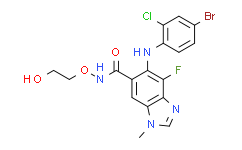Selumetinib (AZD6244, 50 and 100 mg/kg, p.o.) decreases the growth rate of 4-1318 xenografts in a dose-dependent manner; AZD6244 when given at the dose of 50 mg/kg also significantly suppresses the growth of the 5-1318, 2-1318, 26-1004, and 29-1104 xenografts. Selumetinib (ARRY-142886, 10, 25, 50, or 100 mg/kg, p.o.) is capable of inhibiting both ERK1/2 phosphorylation and growth of HT-29 xenograft tumors in nude mice. Tumor regressions are also seen in a BxPC3 xenograft model.



 扫码关注公众号
扫码关注公众号